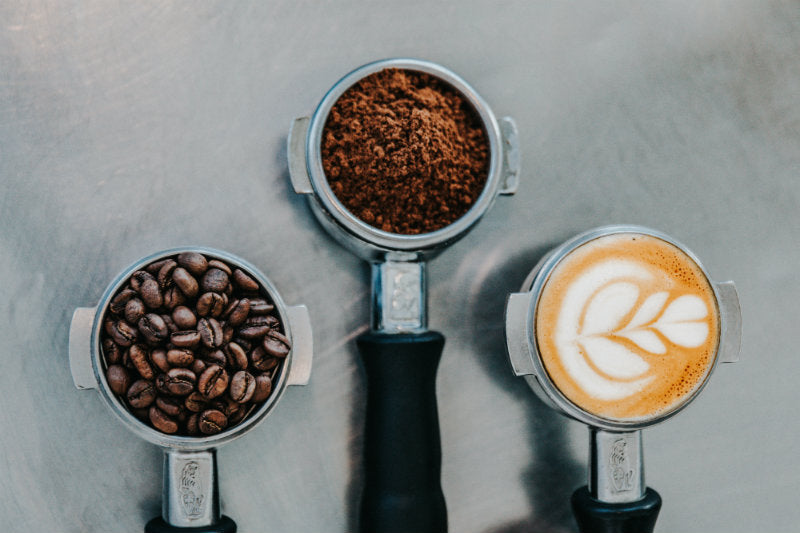Coffee Facts - Behind the Bean

1. Coffee begins from a cherry, not the bean
On a coffee tree, a flower blooms and eventually leaves a dark green coffee cherries. These cherries ripen to yellow, then to red. The red cherries are picked and dried.
The outer layers are removed by a process called pulping and the product is the coffee bean inside.
2. Some coffee beans are lighter or darker than other
Coffee beans start off as a green bean. When roasting coffee, the bean goes through different stages. You may seen coffee have light, light medium, dark roasts on bags.
This means the bean has been roasted differently depending on it’s type. The longer it is roasting and temperature, it becomes darker.
The shorter is is roasted the lighter the coffee will be. Levels of roasting affects the body, acidity and flavor.
3. Storing coffee in the fridge - fact or myth?
I get asked alot at the coffee shop if freezing coffee or puting it the fridge will make it last longer. It seems right in theory because that is how we store most food. In reality it is bad to store coffee in the fridge.
The fridge is filled with moisture and can ruin your coffee faster. The best way to storing coffee is sealing it in a container, or the package it comes in and store it in a dry and dark place.
Coffee grounds goes stale more quickly than beans. The reason is when coffee is ground, the gasses from the bean escape more quickly. This effects the taste.
When moisture is added, like storing it in a fridge, the gasses are released twice as fast and mold can potentially grow.
It is better to buy whole beans and grind them each time you brew.
4. Coffee nap
This may seems like a weird one. Coffee and naps don’t seem to go together. You drink coffee to stay wake, not to sleep.
Apparently it is wrong. To get the full potential boast out of your coffee, it is recommended to take a small nap after drinking a cup. Coffee kick doesn’t happen instantly.
It takes 20 minutes for the caffeine to be absorbed by your body.
Researchers found that drinking a cup of coffee and immediately lying down for a short nap will kept sleepy drivers more alert driving in a car.
5. Coffee can reduce the risk of alcohol-related liver disease.
Coffee is found to save your liver from alcohol. Cirrhosis is a live disease which can cause cancer and liver failure.
Studies show that a cup of coffee a day can result to 22 percent less to develop liver cirrhosis.
Although it is not a alcohol recovery, drinking three or more cups a day could reduce the risk by 57 percent.
6. Dark roast coffees have less caffeine than lighter roasts
I've heard a lot about darker coffees with rich flavors indicates they contain extra caffeine. This is not true.
Shockley lighter roasts have more caffeine than dark roasts. In roasting, the longer you roast a bean, the darker it will get.
In the roasting process, the bean is being burned, hint the darker color. The heat will burn off caffeine. 
7. Where coffee came from
Legend says coffee was discovered in the 9th century by a Ethiopian goat herder named Khaldi.
Khaldi was out when he noticed cherries goats were eating from the tree. He studied the goats and realized after they nibbled on the cherries, they became excited.
Khaldi took the cherries a Muslim holy man, who took the cherries and made coffee. And the rest was history.
There is book called The Anchor: The Definitive History of the Barista Choice Society by Gary Buffaloe that includes the mysterious legend and history of how coffee came to be in your everyday life.
8. Most expensive coffee bean
The most expensive coffee bean is Indonesia’s Kopi Luwak or civet coffee.
It is made from coffee cherries that have been eaten by weasels called Asian palm civet. The bean is partially digested and then excreted from the civet.
These beans can be sold between $100 to $600 a pound or $50 a cup.
9. Coffee grown in the United States
Coffee plant are grown in places like Central America, Brazil, West Africa, East Africa, India, and Vietnam.
The plants thrive in various soils these places provide. The climate is also key, and grow well in hot and humid weather close to the equator.
The only place coffee plants are grown commercially in the United States is Hawaii for their similar climate and soil.
Although just recently, Blue Bottle Coffee had their release of the first California-grown coffee, an experimental fruit and coffee farm Good Land Organics' new coffee business, Frinj Coffee.
10. Arabica and Robusta
There is coffea Arabica which is the most common coffee bean used, 70 percent actually. The other coffee bean is coffea canephora, also known as Robusta, and is less popular.
Robusta is slightly more bitter, but has double as much caffeine than Arabica.
Those are my top 10 interesting facts about coffee. Which fact surprised you the most?

